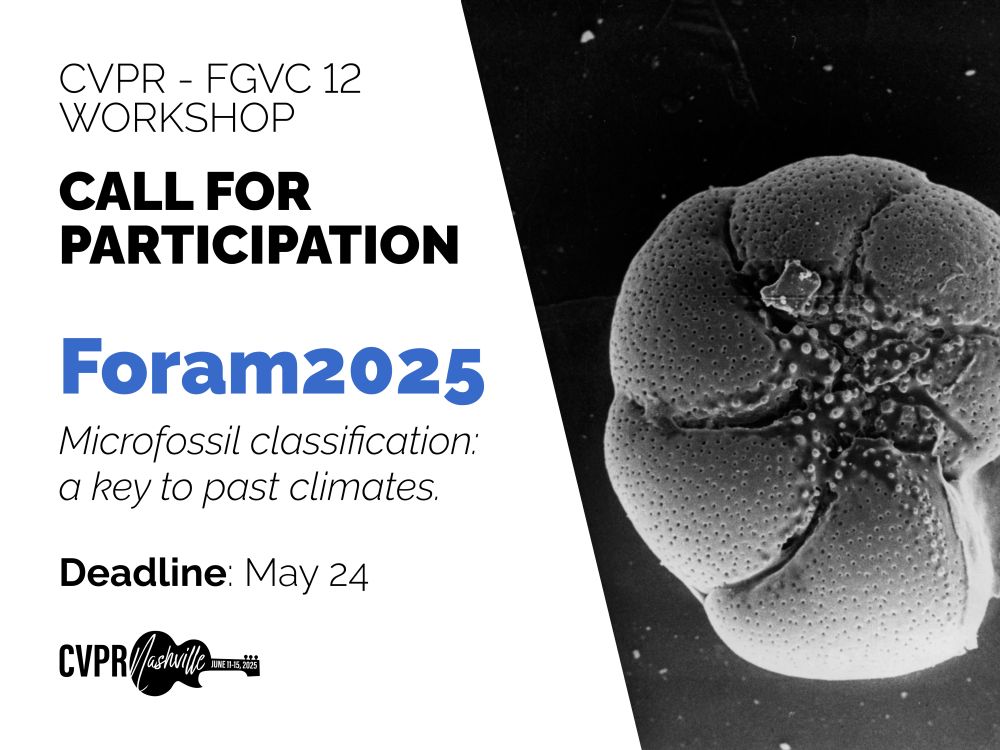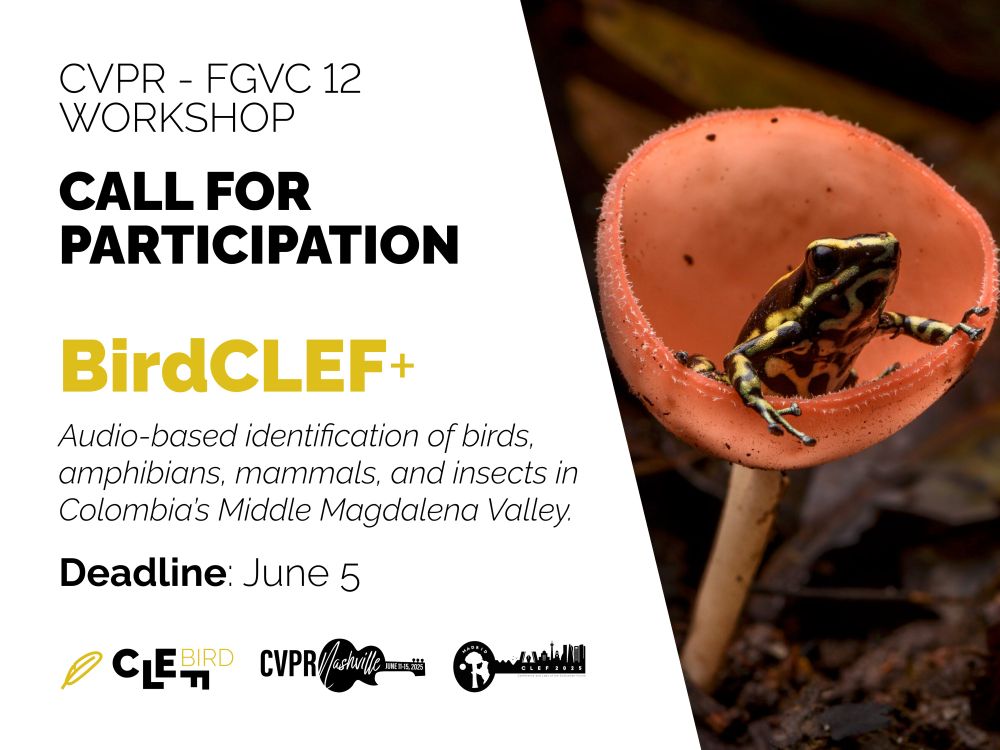
FGVC Workshop
@fgvcworkshop.bsky.social
Workshop on Fine-Grained Visual Categorization (FGVC) - CVPR
Nashville, June 11, 9am-17pm
Room: 104 E
https://sites.google.com/view/fgvc12
Nashville, June 11, 9am-17pm
Room: 104 E
https://sites.google.com/view/fgvc12
We are so excited to have this amazing line-up of speakers!!
Randall Balestriero, Kai Han, Mia Chiquier, Kenneth Marino (@kennethmarino.bsky.social), Elisa Ricci, Thomas Fel (@thomasfel.bsky.social)
Randall Balestriero, Kai Han, Mia Chiquier, Kenneth Marino (@kennethmarino.bsky.social), Elisa Ricci, Thomas Fel (@thomasfel.bsky.social)
June 8, 2025 at 11:30 PM
We are so excited to have this amazing line-up of speakers!!
Randall Balestriero, Kai Han, Mia Chiquier, Kenneth Marino (@kennethmarino.bsky.social), Elisa Ricci, Thomas Fel (@thomasfel.bsky.social)
Randall Balestriero, Kai Han, Mia Chiquier, Kenneth Marino (@kennethmarino.bsky.social), Elisa Ricci, Thomas Fel (@thomasfel.bsky.social)
The challenge is to classify volumetric µCT images of foraminifera tests. With only 210 labeled out of 18,426 volumes, the goal is to develop an efficient species classification method that minimizes annotation time, leveraging semi-supervised learning.
[5/5]
[5/5]
April 15, 2025 at 7:21 AM
The challenge is to classify volumetric µCT images of foraminifera tests. With only 210 labeled out of 18,426 volumes, the goal is to develop an efficient species classification method that minimizes annotation time, leveraging semi-supervised learning.
[5/5]
[5/5]
With µCT scanning, we can scan thousands of forams in a single scan. By determining the species composition, we can efficiently understand how the environment has evolved.
[4/5]
[4/5]
April 15, 2025 at 7:21 AM
With µCT scanning, we can scan thousands of forams in a single scan. By determining the species composition, we can efficiently understand how the environment has evolved.
[4/5]
[4/5]
Since certain types of foraminifera only live in specific conditions, identifying the composition of the foraminifera sediments allows us to gain insights into past environmental conditions.
[3/5]
[3/5]
April 15, 2025 at 7:21 AM
Since certain types of foraminifera only live in specific conditions, identifying the composition of the foraminifera sediments allows us to gain insights into past environmental conditions.
[3/5]
[3/5]
Planktonic foraminifera (aka forams) are tiny organisms that inhabit the sea waters. Forams produce a unique calcium carbonate shell, called a test, which can consist of multiple chambers and exhibit elaborate structures. These are preserved in sea sediments for millions of years.
[2/5]
[2/5]
April 15, 2025 at 7:21 AM
Planktonic foraminifera (aka forams) are tiny organisms that inhabit the sea waters. Forams produce a unique calcium carbonate shell, called a test, which can consist of multiple chambers and exhibit elaborate structures. These are preserved in sea sediments for millions of years.
[2/5]
[2/5]
Foram2025: Classifying microfossil volumes – the first step to understanding past climates.
👉 www.kaggle.com/competitions...
@cvprconference.bsky.social @kaggle.com
#FGVC #CVPR #CVPR2025 QIM Center (qim.dk)
[1/5]
👉 www.kaggle.com/competitions...
@cvprconference.bsky.social @kaggle.com
#FGVC #CVPR #CVPR2025 QIM Center (qim.dk)
[1/5]

April 15, 2025 at 7:21 AM
Foram2025: Classifying microfossil volumes – the first step to understanding past climates.
👉 www.kaggle.com/competitions...
@cvprconference.bsky.social @kaggle.com
#FGVC #CVPR #CVPR2025 QIM Center (qim.dk)
[1/5]
👉 www.kaggle.com/competitions...
@cvprconference.bsky.social @kaggle.com
#FGVC #CVPR #CVPR2025 QIM Center (qim.dk)
[1/5]
This competition aims to identify under-studied species based on their acoustic signatures from continuous audio data. The most effective solutions will demonstrate the ability to train reliable classifiers with limited labeled data.
[4/4]
[4/4]
April 9, 2025 at 10:22 AM
This competition aims to identify under-studied species based on their acoustic signatures from continuous audio data. The most effective solutions will demonstrate the ability to train reliable classifiers with limited labeled data.
[4/4]
[4/4]
Conducting traditional surveys across large areas is costly. In contrast, passive acoustic monitoring, combined with modern ML techniques, enables conservationists to scale with greater temporal resolution, providing deeper insights into the effectiveness of restoration interventions.
[3/4]
[3/4]
April 9, 2025 at 10:22 AM
Conducting traditional surveys across large areas is costly. In contrast, passive acoustic monitoring, combined with modern ML techniques, enables conservationists to scale with greater temporal resolution, providing deeper insights into the effectiveness of restoration interventions.
[3/4]
[3/4]
Mobile and habitat-diverse species serve as valuable indicators of biodiversity change, as shifts in their assemblages and population dynamics can signal the success or failure of ecological restoration efforts.
[2/4]
[2/4]
April 9, 2025 at 10:22 AM
Mobile and habitat-diverse species serve as valuable indicators of biodiversity change, as shifts in their assemblages and population dynamics can signal the success or failure of ecological restoration efforts.
[2/4]
[2/4]
BirdCLEF25: Audio-based species identification focused on birds, amphibians, mammals, and insects in Colombia.
👉 www.kaggle.com/competitions...
@cvprconference.bsky.social @kaggle.com
#FGVC #CVPR #CVPR2025 #LifeCLEF
[1/4]
👉 www.kaggle.com/competitions...
@cvprconference.bsky.social @kaggle.com
#FGVC #CVPR #CVPR2025 #LifeCLEF
[1/4]

April 9, 2025 at 10:22 AM
BirdCLEF25: Audio-based species identification focused on birds, amphibians, mammals, and insects in Colombia.
👉 www.kaggle.com/competitions...
@cvprconference.bsky.social @kaggle.com
#FGVC #CVPR #CVPR2025 #LifeCLEF
[1/4]
👉 www.kaggle.com/competitions...
@cvprconference.bsky.social @kaggle.com
#FGVC #CVPR #CVPR2025 #LifeCLEF
[1/4]
For this competition the dataset contains 79 categories of marine animals of varying taxonomic ranks (e.g., family, genus, species). The challenge is to develop a model that can accurately classify these taxa and ideally leverage their taxonomic information to do so.
[5/5]
[5/5]
April 8, 2025 at 11:17 PM
For this competition the dataset contains 79 categories of marine animals of varying taxonomic ranks (e.g., family, genus, species). The challenge is to develop a model that can accurately classify these taxa and ideally leverage their taxonomic information to do so.
[5/5]
[5/5]
In marine ecology, accurate taxonomic classification is essential for addressing fundamental questions:
--> What species exist in a particular place?
--> What is the ecosystem biodiversity and how does it change over time?
[4/5]
--> What species exist in a particular place?
--> What is the ecosystem biodiversity and how does it change over time?
[4/5]
April 8, 2025 at 11:17 PM
In marine ecology, accurate taxonomic classification is essential for addressing fundamental questions:
--> What species exist in a particular place?
--> What is the ecosystem biodiversity and how does it change over time?
[4/5]
--> What species exist in a particular place?
--> What is the ecosystem biodiversity and how does it change over time?
[4/5]
Is that an Octopus rubescens, commonly found in this area, or is it an Octopus cyanea usually only observed in warm, tropical waters near Hawai’i? Accurate species classification is essential for understanding ocean ecosystems.
[3/5]
[3/5]
April 8, 2025 at 11:17 PM
Is that an Octopus rubescens, commonly found in this area, or is it an Octopus cyanea usually only observed in warm, tropical waters near Hawai’i? Accurate species classification is essential for understanding ocean ecosystems.
[3/5]
[3/5]

